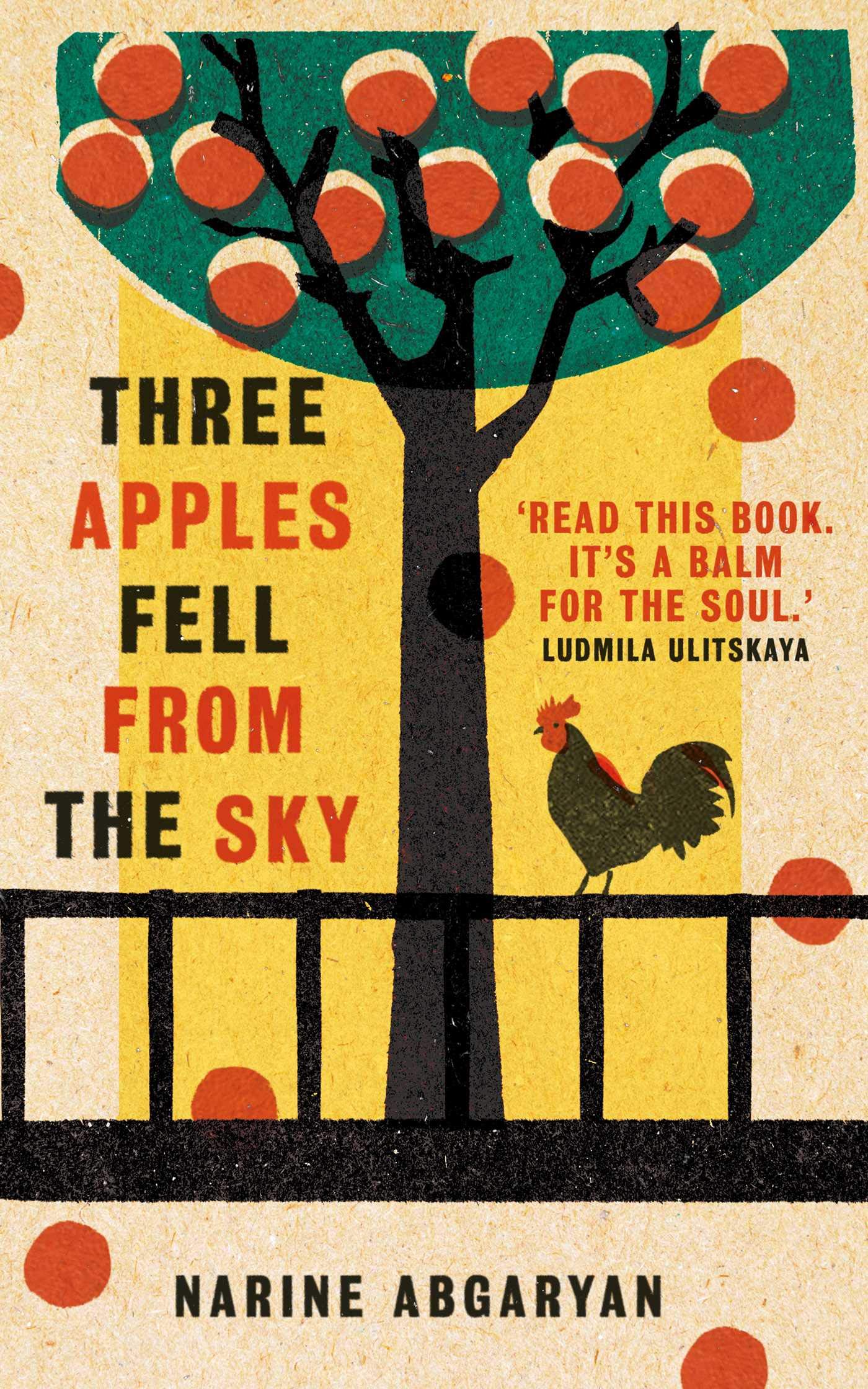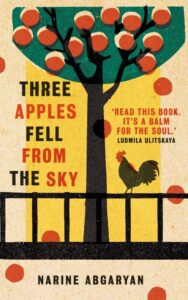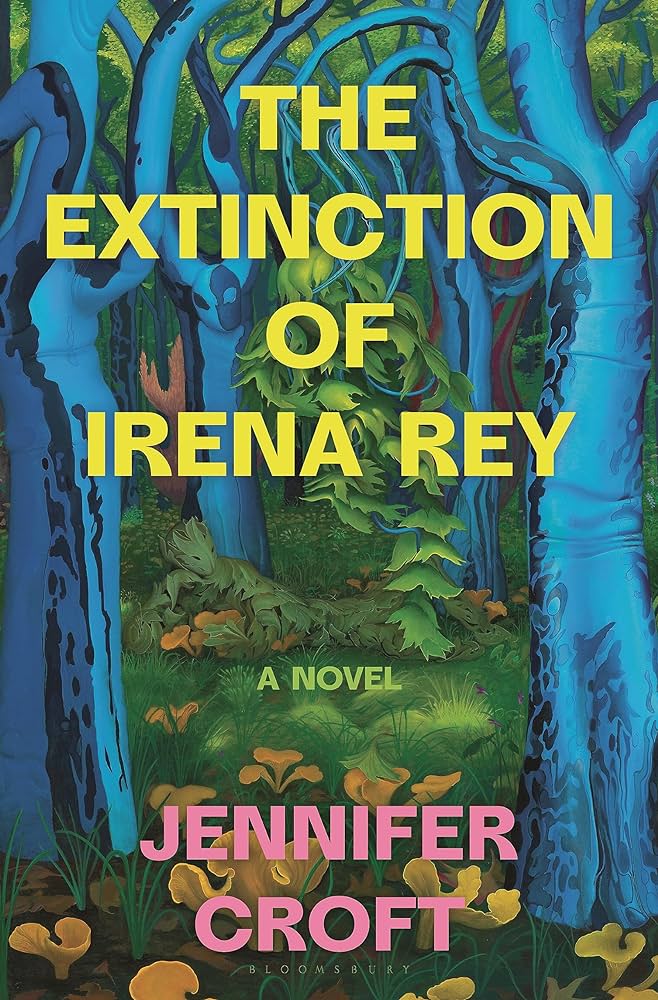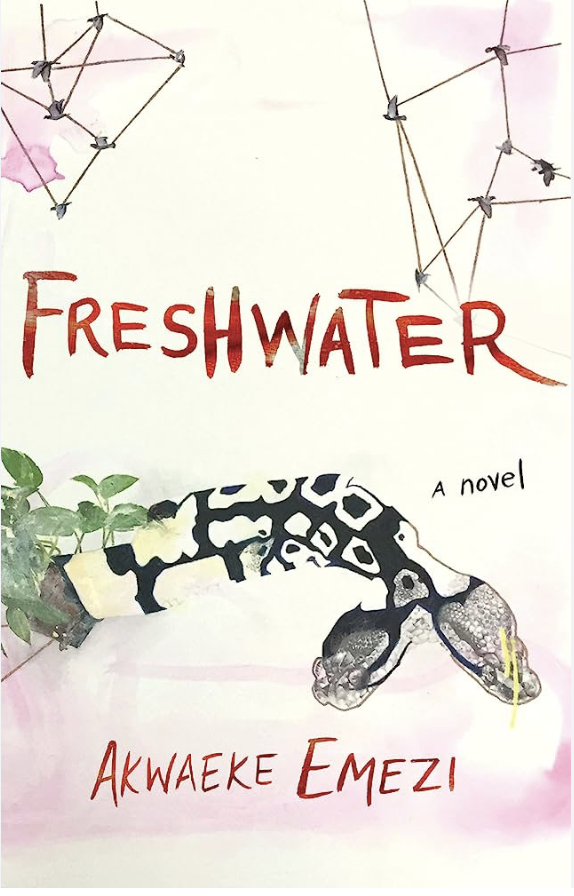(Translated from Russian by Lisa C. Hayden)
reviewed by OLGA ZILBERBOURG
A brave writer begins her novel with the deathbed. Instead of hooking a reader the way the proverbial gun on the wall might, opening with a death scene threatens her with the inevitable backstory.
Luckily, Narine Abgaryan is both a brave and an experienced writer. Three Apples Fell from the Sky is her fifth full-length novel, which won Russia’s prestigious Yasnaya Polyana Literary Award in 2016. Maine-based Lisa C. Hayden translated this novel for Oneworld, and after a COVID19-based delay, the book was released in the UK in August 2020. The novel opens with Anatolia Sevoyants, the protagonist, as she lies down “to breathe her last.” Soon, though, we learn that while Anatolia fully intends to die, life is far from finished with her.
Abgaryan fills the deathbed backstory with action. She begins by showing us Anatolia’s preparations for her final journey—feeding the chickens, opening the lids of the rain barrels in case of thunderstorm, laying out the “grave clothes,” a silver cross, and the money for the neighbors to use for the funeral, each detail hinting at layers of cultural tradition. By the time the author reveals the reason Anatolia thinks she’s dying (she’s experiencing severe vaginal bleeding), the reader finds herself caring deeply about Anatolia’s world and a way of life that seems to be dying with her. As I reached the end of the novel’s second page, I found myself fearing for the fate of Anatolia’s chickens and contemplating a WebMD search for “symptoms of menopause.” Was it possible that Anatolia wouldn’t die, after all?
At fifty-eight, Anatolia is the youngest resident of Maran, a village on the slope of a mountain called Manish-kar—the locations, though fictional, bear distinct resemblance to the north-eastern region of Armenia, where Abgaryan grew up. Once upon a time a bustling town with five hundred families, many farms, and a popular Saturday bazaar, Maran has since dwindled to 23 occupied houses, inhabited by men and women in their sixties, seventies, and eighties. The change took place in just a little over Anatolia’s lifetime. A few years before her birth, a devastating earthquake swept away part of the mountain and half of the families. When Anatolia was seven, there came the famine, which took the lives of most old people and children. Later, when Anatolia was a grown woman, a war broke out that lasted eight years. The town was cut off from the electrical grid and nearly all communications with the outside world, including the town in the valley below, ceased. More people died.
Anatolia is also a survivor of private horrors. She was married for a few years to a man who physically abused her. Her husband, though mentioned several times in the book, remains unnamed, pointedly so in a novel where family names serve as an important part of characterization — for instance, Anatolia’s name, Sevoyants, comes from her “swarthy” grandfather, as “sev,” we learn, means “black” in Maran. Another important character in the novel, Valinka Eibogants, is named after a grandfather who had fought in the “tsar’s army”—presumably, a reference to the Russian Empire—and brought back the Russian expression “Ei-bogu.” “The language was incomprehensible to the other Maranians, but the words meant ‘really and truly,’” Hayden adds, translating to English a phrase that needs no translation to the Russian-language reader.
Though Anatolia’s past is a series of losses, with seemingly little to look forward to in her future, the reader comes to realize that the most tragic loss of all would be her own death: Anatolia had worked as the town’s librarian until the library was destroyed in the war; she is the town’s remaining connection to a literary culture, and as its youngest resident, the town’s main hope to pass on its stories.
While we enter this novel through Anatolia, the reader surmises soon enough that she’s only a faux protagonist of the book. Telling the novel in an omniscient voice through the eyes of several focal characters, Abgaryan soon makes it clear that the town itself is the book’s central preoccupation. The survival of the town and its cultural history is what’s at stake to the author.
To render the richness of Maran’s culture, translator Lisa C. Hayden confidently navigates the linguistic complexities of this book, written in Russian, yet infused with Armenian terms, concepts and ways of being in the world. Nature, household animals, religious and cultural mythology all come together to give Anatolia her reasons for living, and Hayden gives us passages of description and summary with the same energy that she uses for direct action. Contemporary Russian literary style doesn’t shy away from adjectives, and Hayden handles them with ease, as in the case of “swarthy” noted earlier. Her translation is visual and sensory, and she easily follows the author into the rich descriptions of the domestic sphere. The cooking scenes are simply mouth-watering: “Her neighbors’ kitchen smelled deliciously of risen dough: Anatolia always loved that slightly sour aroma, which gave off a cool moistness.” Moistness on its own is an unpleasant sensation, especially as an additive to the sour dough, but “cool moistness” is exquisite.
In Russian-language interviews, Abgaryan has traced the literary genealogy of Maran to Macondo, the town from One Hundred Years of Solitude by Gabriel Garcia Marquez. Macondo, that symbol of the ravages of the Western imperialism, cannot escape the violence of its past, and ceases to exist at the end of the novel. I understand Maran as Abgaryan’s attempt to if not bypass imperial history altogether, then to find a way out of imperialism’s cycle of violence and destruction. Though the narrative includes the perspectives of the male inhabitants of Maran, it’s not particularly concerned with the continuance of a male lineage and with male knowledge. The novel centers the perspectives of the town’s women — they resist their isolation and through the disasters of the century retain their lines of communication with the past, with each other, and with the outside world. The women are the keepers of the land, and their lives are little affected by the presence of Empires or their disappearance.
Neither the Russian Empire, nor the Soviet Union and post-Soviet Armenia are mentioned by name in the novel, and though Maran isn’t completely cut off from modernity — there’s a working telegraph office, and a hospital down in the valley — it might as well be. People here live by the labor of their hands, the produce that they grow, the animals that they care for, and everything that comes from outside of the town is met with suspicion.
Anatolia, for instance, will not go down to the valley to seek medical care for her condition. She doesn’t die, either. Instead, a suitor turns up. The village’s blacksmith, Vasily Kudamants, who has recently lost his wife, comes over with the gift of a brand-new scythe and a marriage proposal. Still believing herself dying, Anatolia accepts Vasily’s proposal to avoid hurting his feelings. Death isn’t fully personalized in this novel—it’s not death with a capital “D”—but it does take on a physical manifestation through this minor character in the novel. With the suitor, the author is clearly having fun with the image of a man with a scythe scaring Anatolia’s death away. As soon as Anatolia says yes to Vasily, she starts to feel better and soon resumes her life—and at this point the narrator’s attention shifts to a different Maranian family.
Formally, this book is divided into three sections and an epilogue, all told by the same unnamed narrator. Though in each of the sections the narrator tells stories about several Maranians, there’s a strong plotline in the book. The first section of the novel gives us the beginning of Anatolia and Vasily’s story, the second introduces us to Valinka Eibogants and her family, and in the third section, the narrator returns to Anatolia and Vasily, showing the way their relationship brings hope to the village. Valinka Eibogants seems to be the only person in Maran who has living descendants, and her section of the novel centers around a visit from her grandson Tigran and his wife Nastasya from “the North” (I can’t help but feel Russia’s presence in this designation), their two children in tow.
This visit is preceded by a dramatic and humorous episode involving an object of outside origin: a packet of dried yeast. Tigran had mailed the yeast for his grandmother to try; Valinka did, finding the result unsatisfying. On the eve of his visit, she decides to dispose of it by throwing it into the cesspit. Overnight, the cesspit spills over and floods part of Valinka’s yard. The whole village gathers to help Valinka clean up the mess—and just in time, to be able to show a good-enough picture to Tigran’s northern wife.
Nastasya, when she arrives, becomes a part of the town’s story, too—and the author shifts part of the novel to her perspective, allowing the reader to see the village through the point of view of an outsider. This part of the novel made me uncomfortable, even though—or precisely because—Nastasya’s point of view coincided the closest with what my own might’ve been had I the opportunity to travel to Maran. Nastasya is very reverential to the women in Maran, she’s there to learn from them, but there’s a clear demarcation between the world of the village and the world outside of it: Nastasya will forever remain a guest, and Valinka, whom she hopes to take to the city with her, cannot leave. Toward the end of the visit, Nastasya takes a dictation of a recipe for a cinnamon cake that she promises her daughter to bake at Christmas. “Can you do it right?” her daughter Alisa quizzes her, and the question incites laughter from Valinka and the other women in the village: the answer is, too obviously, no. To bake the cake right, one has to have spent her life in Maran.
The novel ends with the birth of a baby: Anatolia and Vasily’s union produces a girl, Voske. Together with Tigran and Nastasya’s son, Kirill, the babies are the hope for the village’s survival as the narrator tells us that “a boy and a girl . . . were fated to either cut off the village’s history or think up a new page for it.” The magical prophecy takes the form of two initials that Nastasya had sighted on a town’s wall and had taken down in a drawing. The narrator reports that Maranians recognized this prophecy as such, and then let it go and forgot about it. Their religious beliefs and recipes, their burial customs and medicinal knowledge are so deeply tied to the land on the slope of Manish-kar and its seasons, they all would become meaningless if transplanted from Maran. Will Voske and Kirill—or Kirakos, as he’s named in the village—be able to breathe new life into a dying village? Personally, I doubt it—too much of its culture has already slipped from the physical world into memory. This is a lot to ask of two babies. Though of course Maran is a fictional place—and Narine Abgaryan really wants us to believe in the miraculous power of a very good story.
Olga Zilberbourg is the author of Like Water and Other Stories (WTAW Press) and three Russian-language story collections. She has published fiction and essays in World Literature Today, Electric Literature, Lit Hub, The Believer, CALYX, Alaska Quarterly Review, Confrontation, and elsewhere. She writes book reviews for The Common; co-edits Punctured Lines, a feminist blog about Russian literature; and co-hosts the San Francisco Writers Workshop.





